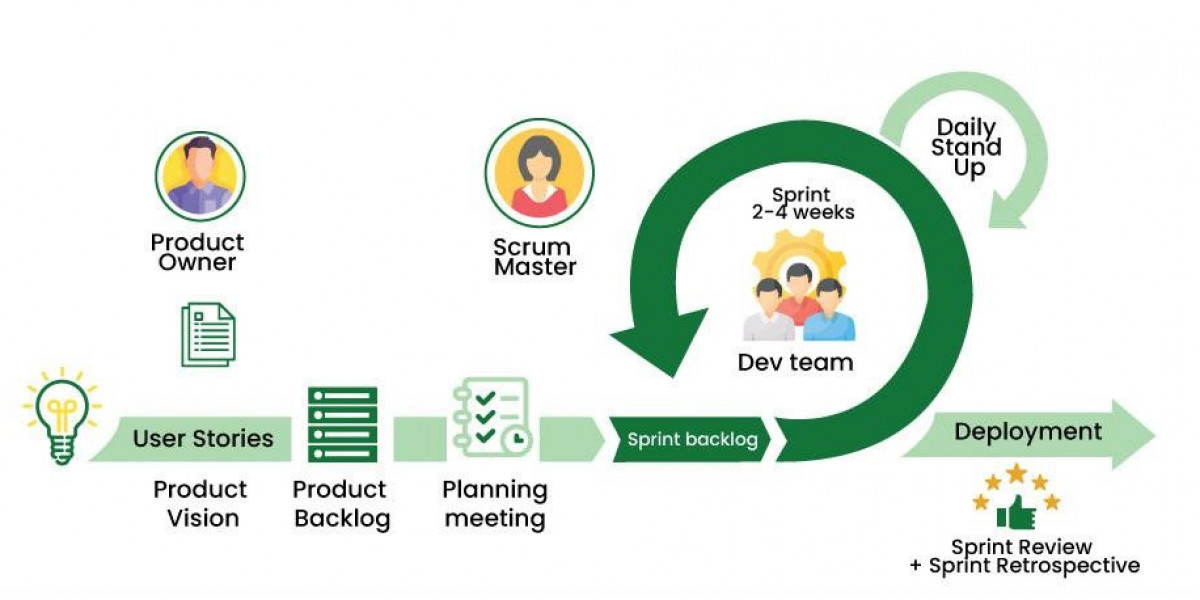In the world of software development, efficiency, flexibility, and collaboration are crucial for success. That’s where the Scrum Development Model comes in. If you’ve ever wondered how Scrum works and why it’s such a popular Scrum framework in Agile methodologies, you’re in the right place. Let’s dive into the details of Scrum methodology, its processes, and why it’s an essential approach for Scrum project management.
What is Scrum?
Scrum is an Agile Scrum development framework designed to help teams develop, deliver, and sustain complex products efficiently. It enables cross-functional teams to work in short, iterative cycles called sprints, ensuring continuous improvement and quick responses to change.
Scrum is widely used in software development, but its principles can be applied across various industries, from marketing to manufacturing. The core idea behind Scrum methodology is to encourage collaboration, transparency, and continuous feedback for better project outcomes.
Also Read: Scrum Development Model: How It Works and Why It’s Effective
How the Scrum Development Model Works
The Scrum Development Model operates through a structured yet flexible process that consists of Scrum roles, Scrum events, and Scrum artifacts.
Scrum Roles
Every Scrum framework consists of three primary roles:
- Scrum Master: Facilitates the Scrum process, removes obstacles, and ensures the team follows Scrum principles.
- Product Owner: Represents stakeholders, prioritizes the backlog, and ensures the product delivers value.
- Development Team: A self-organizing group of professionals responsible for delivering the product increment.
Scrum Events
Scrum follows a structured workflow with predefined events to keep the process organized:
- Sprint Planning: Defines the sprint goal and selects backlog items.
- Daily Standup Meetings: Short daily meetings to track progress and identify roadblocks.
- Sprint Review: Demonstrates the completed work to stakeholders.
- Sprint Retrospective: Reflects on the sprint, identifying improvements for the next cycle.
Scrum Artifacts
Artifacts in Scrum provide transparency and clarity in the development process:
- Product Backlog: A prioritized list of tasks and features for the product.
- Sprint Backlog: Selected items from the product backlog for a sprint.
- Increment: The completed portion of the product that meets the definition of done.
Benefits of Using Scrum for Project Management
Using Scrum project management comes with several advantages:
- Increased Flexibility: The iterative approach allows teams to adapt to changes quickly.
- Better Collaboration: Encourages communication between teams and stakeholders.
- Higher Productivity: Focused work in sprints leads to faster development.
- Enhanced Quality: Regular testing and feedback ensure a high-quality product.
- Transparency: Continuous updates and reviews keep everyone informed.
Common Challenges in Scrum Implementation
Despite its benefits, Scrum methodology has its challenges:
- Resistance to Change: Some teams struggle with adapting to Agile principles.
- Unclear Roles: Lack of understanding about Scrum roles can cause confusion.
- Scope Creep: Frequent changes in backlog can delay the project.
- Lack of Experience: Without proper training, teams may misuse Scrum practices.
FAQs
Q:1. What is the Scrum development model?
Ans: The Scrum development model is an Agile framework used for project management, emphasizing iterative development, continuous feedback, and cross-functional collaboration.
Q:2. How does Scrum work?
Ans: Scrum works by dividing the project into time-boxed sprints, where teams complete prioritized tasks and review progress regularly.
Q:3. What are the key benefits of Scrum?
Ans: Key benefits of Scrum include faster delivery, improved collaboration, high flexibility, and better-quality control.
Q:4. What is the role of a Scrum Master?
Ans: The Scrum Master is responsible for facilitating the Scrum process, removing impediments, and ensuring the team adheres to Agile principles.
Q:5. How is Scrum different from Agile?
Ans: Scrum is a framework under Agile, while Agile is a broader philosophy that includes various methodologies like Scrum, Kanban, and Lean.
Conclusion
The Scrum Development Model has revolutionized project management by providing a structured yet adaptive approach to software development. By leveraging Scrum methodology, teams can work efficiently, collaborate seamlessly, and deliver high-quality products faster.
Whether you’re a developer, project manager, or business owner, adopting Scrum project management can help streamline your workflow and achieve better results.
Read Our Informative Blog’s:
https://negiseogaurav.blogspot.com/2025/01/best-mobile-app-development-company-for.html
https://negiseogaurav.weebly.com/blog/best-mobile-app-development-company-for-enterprises-in-india
https://gauravnegi.godaddysites.com/f/best-mobile-app-development-company-for-enterprises-in-india
https://telegra.ph/Best-Mobile-App-Development-Company-for-Enterprises-in-India-01-31
https://negiseogaurav.hashnode.dev/best-mobile-app-development-company-for-enterprises-in-india
https://timessquarereporter.com/news/best-mobile-app-development-company-for-enterprises-in-india
https://www.diigo.com/item/note/bao94/g7x4?k=9455186835362e83fe0e4755f02a8114
https://www.pearltrees.com/negiseogaurav/item690209989
https://groups.google.com/g/enterprises-mobile-app-development-company/c/NsdFs2DXsMY
https://colab.research.google.com/drive/1jfzre-BJvt4ybDXvaNu_1UvTeIE4InHr?usp=sharing
https://anjanettes-fresh-site.webflow.io/
https://www.geocities.ws/enterprises-app-development/
https://gauravnegi.siterubix.com/best-mobile-app-development-company-for-enterprises-in-india/









